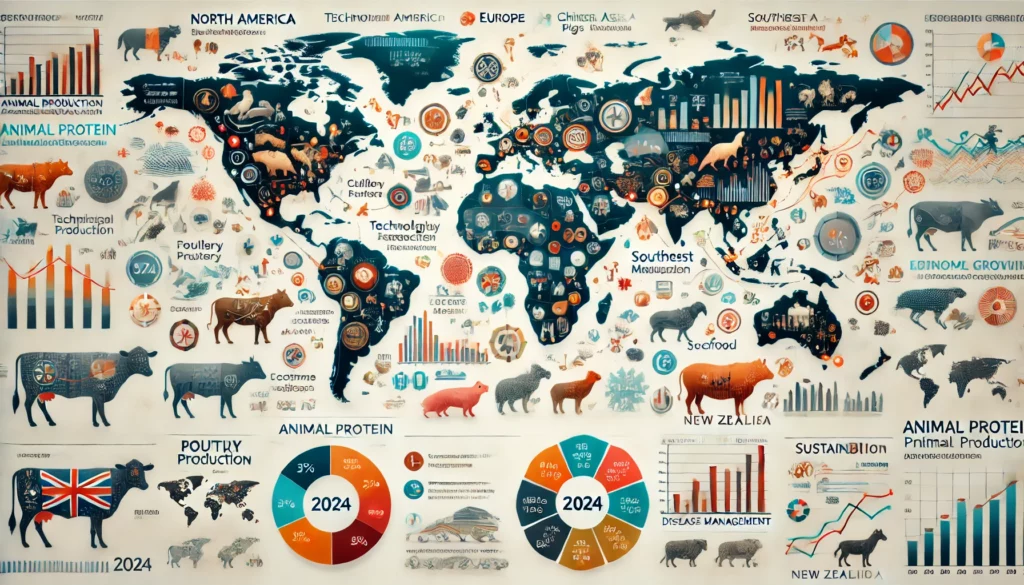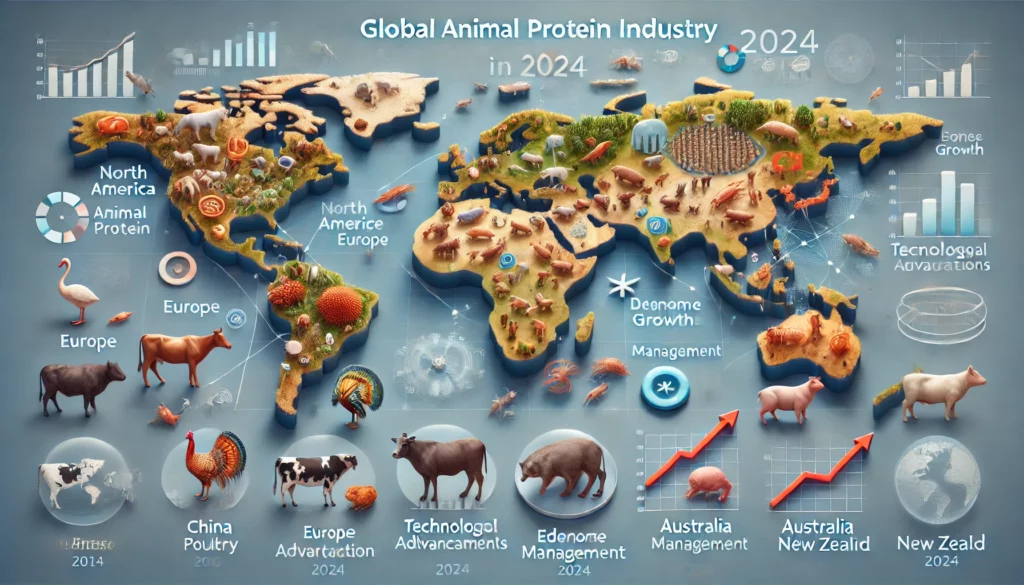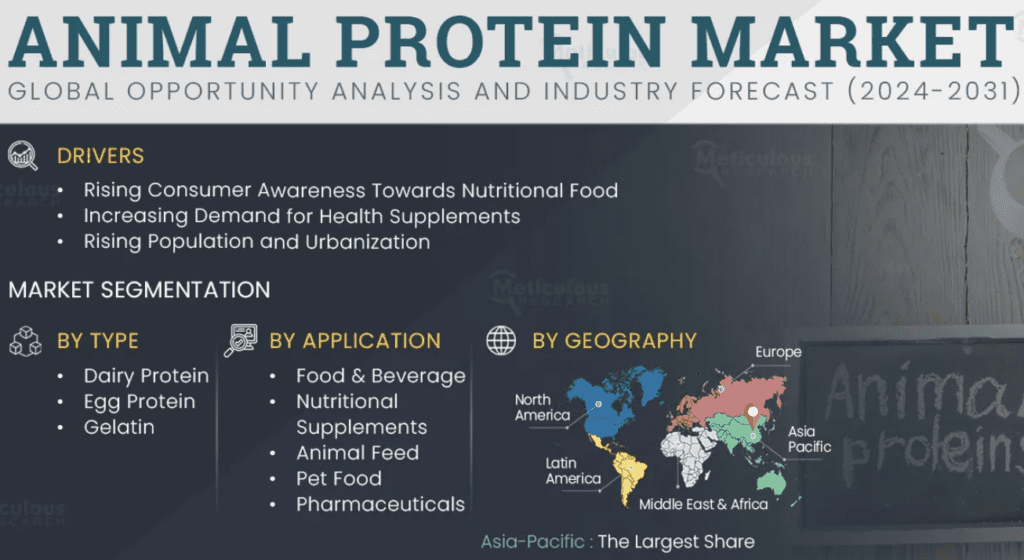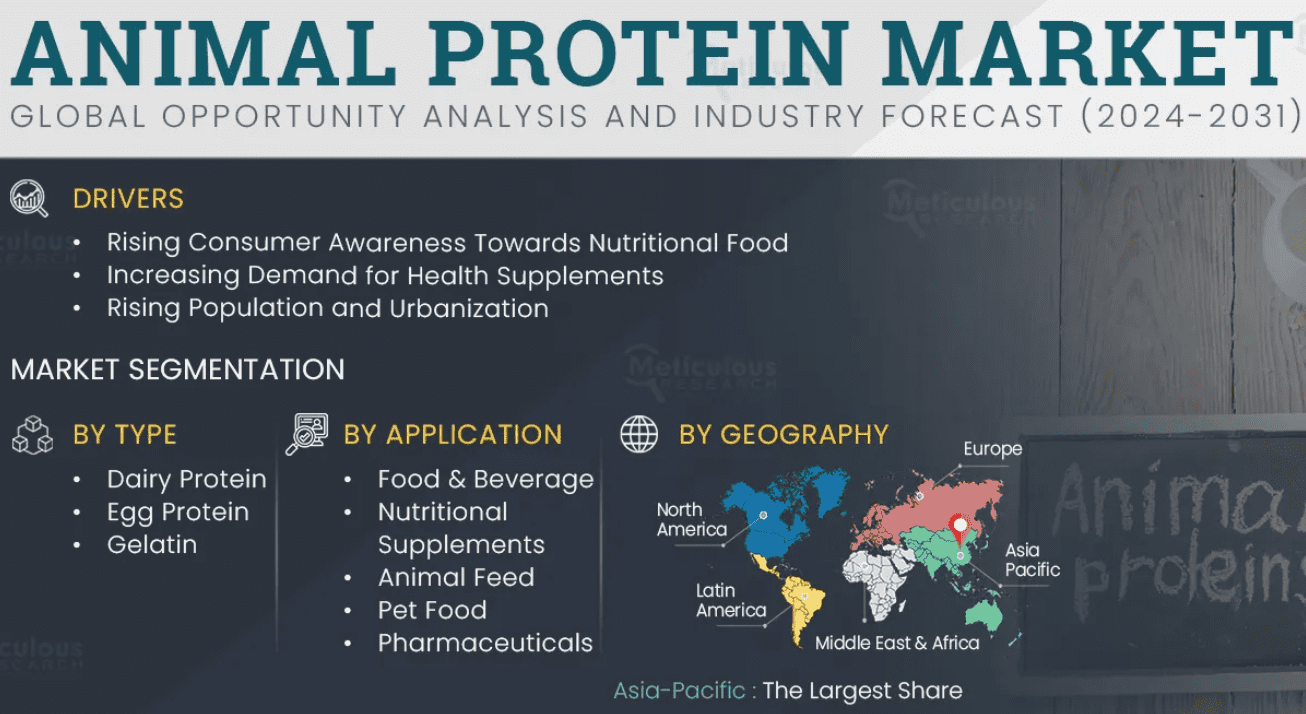Industry Overview
The global animal protein industry is set to experience slower growth in 2024, marking a significant shift from the robust growth observed over the past few years. This deceleration is primarily driven by higher production costs, tighter margins, and various structural changes within the market. Despite these challenges, the demand for animal protein remains resilient due to the sector’s adaptability and continuous efforts to meet consumer expectations (Rabobank) (Perstorp).
Regional Insights
North America: In North America, the beef sector is expected to continue its contraction due to cyclical changes, while poultry benefits from consumer preferences and relatively lower costs. Pork production remains challenged, needing to rebalance supply and demand dynamics (Rabobank).
Europe: European producers face significant pressures from disease risks, regulatory changes, and declining exports. However, poultry consumption is expected to grow, contrasting with declining pork and beef markets (Rabobank) (Triton News).
China: China’s animal protein market will see slow consumption growth, with poultry positioned as the best-performing sector. Both pork and beef will face pressures due to an already well-supplied market, particularly in the first half of 2024 (Rabobank).
Brazil: Brazil will experience growth across all species, driven by strong export opportunities. Pork production will see the fastest growth, followed by poultry, though disease remains a potential risk, especially for poultry (Rabobank) (Triton News).
Southeast Asia: Recovering economies and easing disease pressures will support production growth in Southeast Asia. Pork production will lead this growth, followed by poultry, with beef seeing minimal changes from 2023 levels (Rabobank).
Australia and New Zealand: Australia is set to see increased beef production due to herd rebuilding, while New Zealand will experience a slight slowdown in beef production but an increase in sheepmeat production (Rabobank) (Sheep Central).

Detailed Elaboration on Regional Insights for the Animal Protein Industry in 2024
North America
Beef: The beef sector in North America, particularly in the U.S., is expected to continue its contraction. This decline is largely driven by cyclical changes in cattle production and market conditions. As beef production contracts, it casts a shadow over changes in other species, impacting the overall meat supply landscape (Rabobank) (Triton News).
Poultry: Poultry is poised to benefit from strong consumer preferences. Lower feed costs and a high demand for affordable protein options are likely to stimulate poultry production and consumption. The focus on affordability and efficiency will drive growth in this sector, although at a slightly reduced pace compared to previous years (Rabobank).
Pork: Pork production in North America faces the challenge of rebalancing supply and demand. While there is potential for growth, the sector needs to manage oversupply issues and adjust to market demands to achieve stability (Rabobank) (Triton News).
Europe
Production Pressures: European producers are under significant pressure due to disease risks, regulatory changes, and market-driven production system adjustments. These challenges are expected to continue influencing the production levels across all animal protein sectors (Rabobank).
Poultry: Despite the pressures, poultry consumption in Europe is set to grow. This growth is supported by consumer preferences for poultry as a cost-effective and versatile protein source (Triton News).
Pork and Beef: Both pork and beef markets in Europe are projected to decline. The decline is attributed to lower exports, regulatory constraints, and changing consumer preferences. Producers will need to adapt to these conditions by optimizing their operations and exploring new market opportunities (Rabobank) (Sheep Central).
China
Slow Consumption Growth: China’s animal protein market will continue to experience slow consumption growth in 2024. This slow growth is partly due to the already well-supplied market and economic uncertainties affecting consumer spending (Triton News) (Sheep Central).
Poultry: Poultry production and consumption in China are expected to see steady growth. Poultry remains well-placed to meet the demands of a price-sensitive market, providing an affordable protein option for consumers (Rabobank).
Pork and Beef: Both pork and beef markets will face pressure due to oversupply and slow consumption. However, strategic adjustments in production and marketing can help mitigate some of these challenges (Triton News).
Brazil
Growth Across Species: Brazil is set to experience robust growth across all animal protein species, driven by strong export opportunities. The country’s favorable climate and efficient production systems support this growth (Rabobank) (Sheep Central).
Pork: Pork production in Brazil will see the fastest growth, followed closely by poultry. This growth is propelled by high international demand and competitive pricing (Triton News).
Disease Risks: Despite the positive outlook, disease remains a downside risk, particularly for poultry. Ongoing efforts to manage and mitigate disease outbreaks are crucial to sustaining growth (Rabobank).
Southeast Asia
Economic Recovery: Southeast Asia’s recovering economic situation and easing disease pressures are expected to support production growth in 2024. Economic improvements are likely to boost consumer spending on animal proteins (Rabobank) (Triton News).
Pork: Pork production will lead growth in the region, although it remains subject to ongoing African Swine Fever (ASF) pressures. Effective disease management and biosecurity measures are essential for sustaining this growth (Sheep Central).
Poultry: Poultry production will also see significant growth, supported by rising demand and improved production conditions. The sector’s ability to provide affordable protein options will drive its expansion (Rabobank).
Beef: Beef production in Southeast Asia is expected to see minor changes from 2023 levels. While there is potential for growth, the sector faces challenges related to market access and competition from other proteins (Triton News).
Australia and New Zealand
Beef Production: Australia’s beef production is set to grow as the country rebuilds its beef herd. Favorable conditions in previous years have supported herd expansion, which will translate into increased production and exports in 2024 (Rabobank) (Sheep Central).
Sheepmeat: New Zealand’s production of sheepmeat is expected to expand slightly, while beef production will slow down marginally. This expansion is supported by strong export demand and efficient production practices (Rabobank).
Climate Impact: Dry conditions anticipated in 2024 may impact average slaughter weights and overall production volumes. However, increased livestock numbers and robust export demand are expected to sustain production levels (Sheep Central).

Market Trends and Challenges
Poultry and Aquaculture: Poultry and aquaculture are the only sectors expected to witness production growth in 2024, albeit at a slower pace than previous years. Poultry, in particular, will benefit from lower feed costs and continued consumer demand for affordable protein options (Rabobank) (Triton News).
Beef and Pork: Both beef and pork production are anticipated to decline. Beef production is impacted by cyclical changes and market conditions in North America, while pork faces modest contractions globally due to supply and demand imbalances (Rabobank) (Triton News).
Alternative Proteins: The demand for plant-based meat alternatives is expected to decline, with the food service sector becoming the primary market for these products. This decline is attributed to both consumer preferences and investor sentiments shifting away from plant-based options (Triton News) (Sheep Central).
Input Costs and Consumer Prices: While input costs and inflation are expected to ease slightly from their peaks during the pandemic, they will remain elevated compared to pre-pandemic levels. This will likely result in higher prices for animal protein, impacting global consumption patterns. However, a segment of consumers appears willing to pay a premium for high-quality products (Rabobank) (Triton News).
Regulatory and Market Changes: The industry faces ongoing challenges from regulatory requirements and market-driven changes, particularly around sustainability and animal welfare. Companies need to invest in upgrading production systems and improving operational efficiencies to navigate these challenges successfully (Rabobank) (Sheep Central).
Strategic Recommendations
To thrive in this evolving landscape, animal protein companies should focus on the following strategic actions:
- Boost Productivity: Intensify efforts to enhance productivity through technological advancements and efficient resource management.
- Review Product Portfolios: Reassess and diversify product offerings to meet changing consumer preferences and market demands.
- Strengthen Supply Chains: Fortify partnerships across the supply chain to ensure stability and resilience.
- Invest in Innovation: Increase investments in new product development, particularly in high-value and premium product segments.
- Adjust Pricing Strategies: Develop pricing strategies that reflect the cost pressures and consumer willingness to pay for premium products (Rabobank) (Perstorp) (Triton News).

Detailed Elaboration on Strategic Recommendations for the Animal Protein Industry in 2024
1. Boost Productivity
Boosting productivity in the animal protein industry is crucial to offset the high operational costs and tight margins. Here are key areas where companies can enhance productivity:
Technological Advancements: Investing in automation, precision farming, and data analytics can significantly enhance operational efficiency. Technologies like IoT (Internet of Things), AI (Artificial Intelligence), and blockchain can optimize supply chains, improve animal health monitoring, and ensure traceability from farm to fork (Rabobank) (Perstorp).
Efficient Resource Management: Implementing sustainable practices to reduce waste and improve resource utilization is essential. Efficient water usage, waste recycling, and energy-saving technologies can help reduce costs and environmental impact (Triton News) (Sheep Central).
Genetic Improvement: Selective breeding and genetic advancements can lead to more resilient and productive livestock. For example, genetic selection for disease resistance can reduce mortality rates and improve overall productivity (Rabobank).
2. Review Product Portfolios
Reassessing and diversifying product portfolios allows companies to better meet changing consumer preferences and market demands:
Market Segmentation: Understanding different market segments and tailoring products to meet specific consumer needs can open up new revenue streams. For instance, offering organic, antibiotic-free, or premium meat products can cater to health-conscious consumers willing to pay a premium (Triton News).
Product Innovation: Developing new products that align with consumer trends, such as ready-to-eat meals, high-protein snacks, and plant-based meat alternatives, can diversify revenue sources and reduce dependency on traditional products (Sheep Central).
Sustainability and Animal Welfare: Products that emphasize sustainability and animal welfare can attract eco-conscious consumers. Transparent labeling and certifications (e.g., free-range, grass-fed) can also enhance brand reputation and market appeal (Perstorp).
3. Strengthen Supply Chains
Building robust and resilient supply chains is critical to navigating market uncertainties and ensuring consistent product quality:
Partnerships and Collaborations: Strengthening partnerships with suppliers, distributors, and retailers can enhance supply chain stability. Collaborative efforts can lead to better risk management and more efficient logistics (Rabobank).
Local Sourcing: Increasing local sourcing can reduce dependency on international supply chains, which are often subject to geopolitical tensions and trade disruptions. Local sourcing can also reduce transportation costs and carbon footprint (Triton News).
Supply Chain Transparency: Utilizing blockchain and other technologies to enhance transparency can build trust with consumers and stakeholders. Transparent supply chains can ensure product traceability and authenticity, crucial in today’s market (Perstorp) (Sheep Central).
4. Invest in Innovation
Continued investment in innovation is essential for staying competitive and meeting future market demands:
Research and Development (R&D): Allocating resources to R&D can lead to breakthroughs in product development, animal health, and production efficiency. Innovations in feed formulations, veterinary care, and farming techniques can improve productivity and sustainability (Rabobank) (Triton News).
Sustainable Practices: Innovating in sustainability can provide long-term benefits. For example, developing biodegradable packaging, utilizing renewable energy sources, and implementing circular economy principles can enhance brand value and reduce environmental impact (Rabobank).
Consumer Engagement: Investing in consumer engagement and education about new products and sustainable practices can drive demand and brand loyalty. Marketing strategies that highlight innovation and sustainability can attract a broader consumer base (Triton News).
5. Adjust Pricing Strategies
Effective pricing strategies are crucial to navigate the high costs and ensure profitability:
Value-Based Pricing: Adopting value-based pricing can capture the premium that consumers are willing to pay for high-quality, sustainable, and ethically produced products. Understanding consumer willingness to pay can help set prices that reflect product value (Perstorp).
Dynamic Pricing: Implementing dynamic pricing strategies can help companies adjust prices based on market conditions, demand fluctuations, and input cost changes. Real-time data analytics can support dynamic pricing decisions (Sheep Central).
Promotional Strategies: Targeted promotions and discounts can attract price-sensitive consumers while maintaining overall profitability. Seasonal promotions, loyalty programs, and bundled offers can enhance sales without significantly eroding margins (Triton News).
Conclusion
The animal protein industry in 2024 will navigate through a complex array of challenges and opportunities. While growth will slow, the sector’s resilience and adaptability position it well to meet ongoing consumer demand and capitalize on emerging market opportunities. Companies that strategically adapt to the evolving market conditions and invest in innovation and efficiency will likely emerge stronger in the long term.

